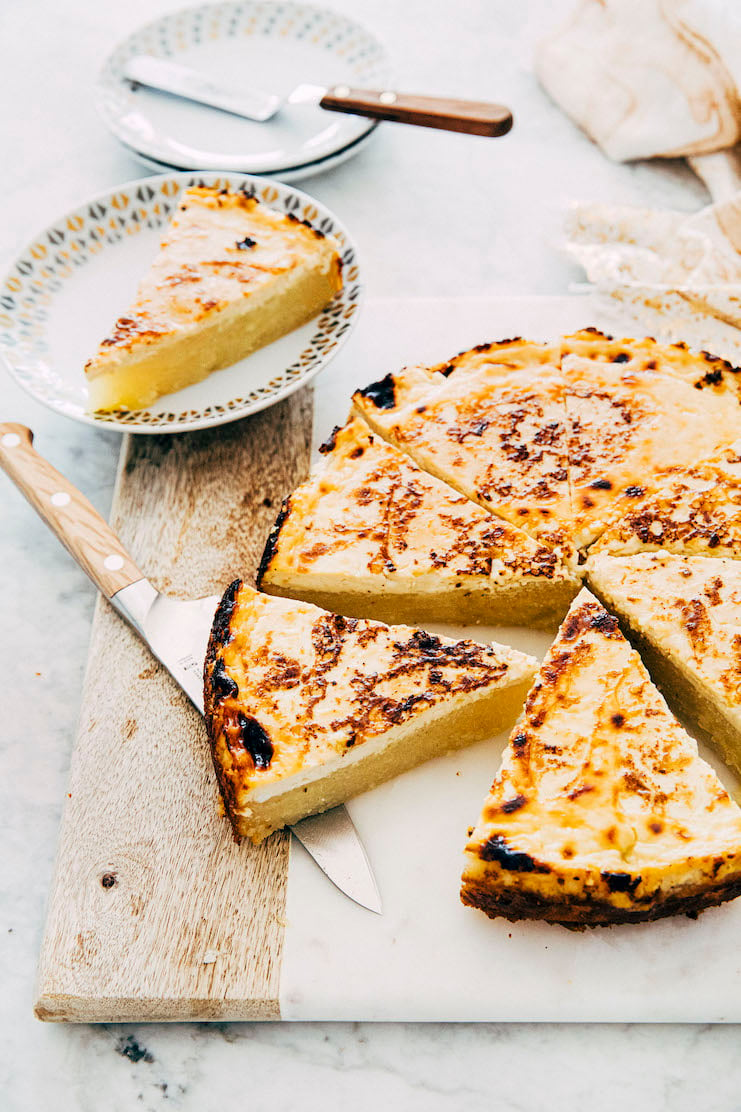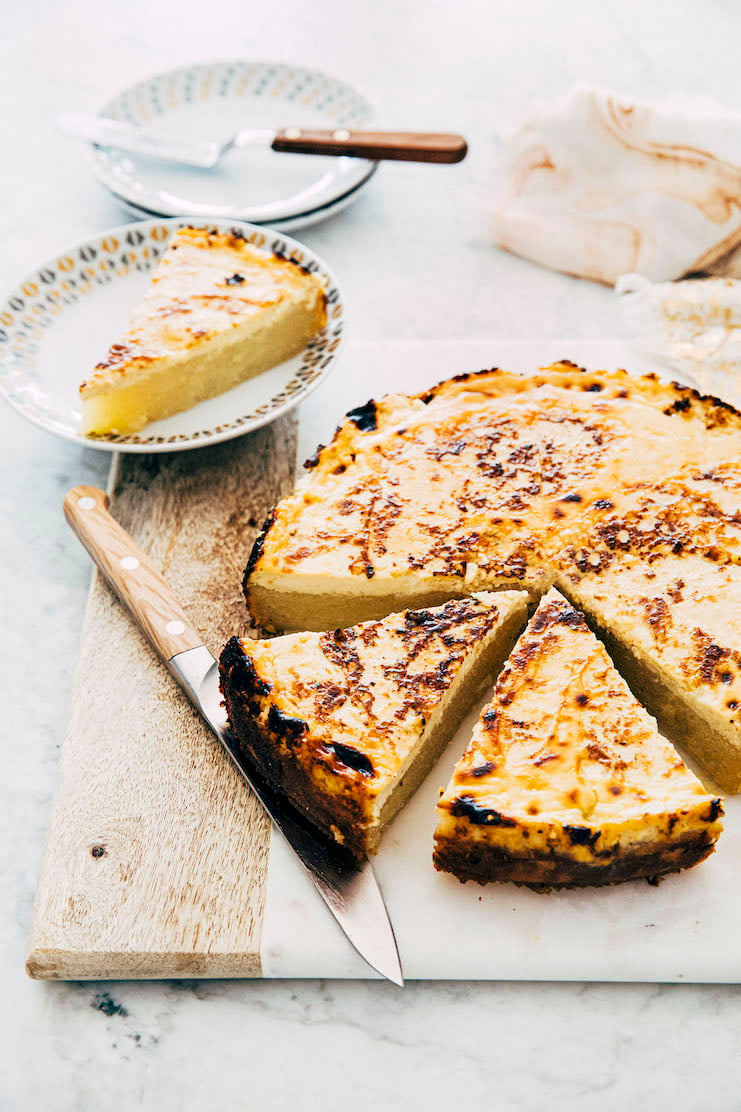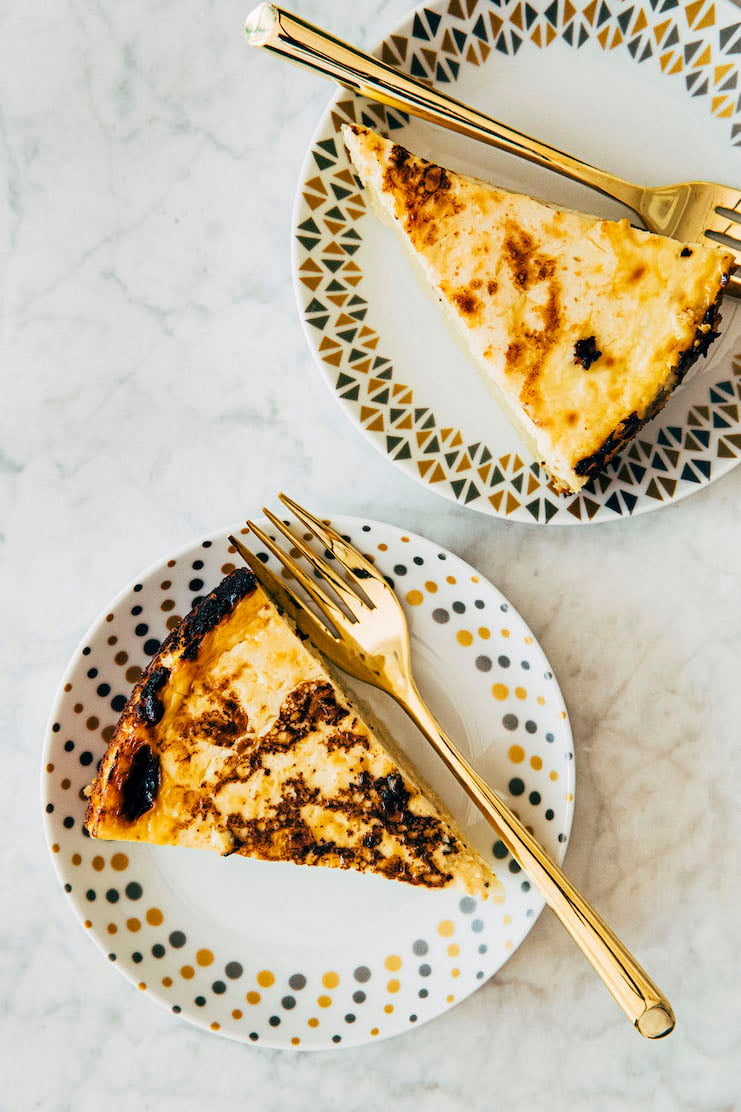
About This Cassava Cake Recipe
Cassava cake is a traditional Filipino snack cake made with grated cassava, coconut milk, and a layer of molten custard on top. The cake is typically gluten free, with a soft and slightly chewy crumb from the cassava. Its texture is very similar to that of Hawaiian butter mochi cake and other sweet rice flour-based desserts.
@hummingbirdhigh filipino cassava cake hits different i swear #filipinofood #bakingrecipe ♬ original sound – hummingbirdhigh
For more unique Filipino dessert recipes, check out Hummingbird High‘s Ube Recipes round-up! Popular recipes include these Ube Crinkle Cookies and these Small Batch Baked Ube Mochi Donuts.
What Does Cassava Cake Taste Like?
I mentioned this earlier, but it bears repeating: I like to think of cassava cake as the Philippine version of Hawaiian mochi butter cake. Because cassava is so mild-flavored, this cake mostly tastes like all the other ingredients in it! The cassava cake has a mildly sweet, milky flavor from the combination of coconut milk, evaporated milk, and sweetened condensed milk in the recipe.
That being said, despite not adding too much in the way of flavor, cassava still plays a prominent role in this recipe. Why? The cassava is responsible for the cake’s distinct, chewy texture. The cake manages to be both soft and firm all at once, and is chewy and sticky without being overly gummy or gross. It’s hard to describe! But if you’re the kind of person who likes Hawaiian butter mochi cake, Japanese mochi sweets, and the boba pearls in bubble tea, you’re going to LOVE cassava cake. I promise.

Why You Should Make This Recipe
This cassava cake recipe is an updated take on a classic, authentic Filipino cassava cake recipe.
This recipe is based on my mom’s recipe for cassava cake, which she in turn adapted from classic Filipino resources like Positively Filipino and the cookbook, Let’s Cook with Nora. The latter is a prominent Filipino cookbook. It was first published in 1969 and quickly became ubiquitous.
Growing up, I remember EVERY Filipino household having a copy of Let’s Cook with Nora in their kitchen. Its influence is multi-generational. It was used by both my mom and my lola (the Filipino word for grandmother) extensively. However, Let’s Cook with Nora really hit its stride in the 1980s when its original author hosted a cooking show on TV. Even now, it remains influential: Nora’s daughter recently updated the beloved classic in 2019.
But here’s the thing—as much as I love using and referencing old cookbooks, they can be hard to cook from! Let’s Cook with Nora‘s instructions are often sparse; often times, no precise measurements or cooking times are given. A big part of that has to do with what cooking was like in the 1950s and 1960s. For instance, my own lola made the BEST leche flan (the Filipino version of creme caramel) without measuring any ingredients. She would just measure ingredients by look, feel, and taste. In a pinch, she would use empty cups and milk cans as measuring utensils when necessary.
As much as I admire that skill (and I really, truly do!), modern recipe writing now favors accuracy and precision. Folks expect as much detail as possible to help them achieve the best dish, baked good, and whatever else! As a result, I’ve updated the recipe with more precise measurements and queues.
This cassava cake recipe is gluten-free!
Traditional cassava cake recipes don’t require any flour. Instead, the cake is made simply from the combination of cassava, eggs, and milk! Because cassava is a root, it does not contain any gluten whatsoever.
This cassava cake recipe comes together quickly.
The most time consuming part of this recipe is actually baking and broiling the cassava cake itself. But the cassava cake batter comes together in 5 minutes: simply whisk the ingredients together and pour it into the prepared pan. That’s it!

Ingredients and Substitutions
Now that I’ve convinced you to make this cassava cake, here’s your shopping list for the recipe:
Shopping List for Cassava Cake Recipe
- granulated sugar
- kosher salt
- large eggs
- canned coconut milk
- evaporated milk
- frozen grated cassava
- sweetened condensed milk
- large eggs
- pure vanilla extract
- unsalted butter
And let’s talk about some of the key ingredients in the recipe:
Ingredient Sources and Substitutions
- Kosher Salt. Kosher salt is the best salt for baking recipes. But you can replace the kosher salt in the recipe with table salt. Just use half the amount listed in the recipe when you do!
- Cassava. This cassava cake recipe uses 1 (16-ounce) pack frozen grated cassava. If you’re serious about making this recipe, I highly suggest shopping at a specialty Asian supermarket. Asian supermarkets are more likely to have both fresh AND frozen cassava on hand.
For this recipe, I recommend you buy frozen grated cassava. In a pinch, you can buy the peeled whole cassava roots and/or diced cassava cubes, but you’ll need to grate them before using them in the recipe. Why not save yourself the work and buy it pre-grated instead? - Canned Coconut Milk. Canned coconut milk is now available in most major grocery stores in the United States. Canned coconut milk is typically found in the “Asian” aisle. However, “fancier” grocery stores like Trader Joe’s and Whole Foods even offer their own generic versions of coconut milk! Look for them in either the baking or canned goods aisle. So what’s the best canned coconut milk? My personal favorite is Arroy-D coconut milk.

How To Make The Recipe
Here are the basic steps to make cassava cake:
- First, prep your ingredients. (Prep Time: 5 minutes)
Honestly, prepping the ingredients for this recipe is more time-consuming than the cake itself! Depending on what route you decide to take for your cassava, you’ll need to prep it for this recipe. My prep consisted of thawing the frozen grated cassava overnight in the refrigerator. You’ll also need to divide both the coconut milk and evaporated milk in half. The first halves will be used in the cassava cake batter, while the remaining halves will be used for the custard topping. - Make the cassava cake batter. (Work Time: 5 minutes)
Whisk together the sugar, salt, eggs, milks, and cassava. Boom! That’s all you need to do to make the cake batter. Easy, right? - Bake the cake. (Bake Time: 40 minutes)
You’ll need to bake the cassava cake for 40 minutes, or until the edges are set and a skewer inserted into the center of the cake comes out with few crumbs attached. - Make the custard topping. (Work Time: <5 minutes).
While the cake is in the oven, make the custard topping. Whisk together the remaining milks with an egg. Again, that’s all you need to do! Told you this recipe was easy. - Broil the cake. (Bake Time: 15 minutes)
Pour the custard topping over the cassava cake, and then stick the entire thing in the broiler until the custard gets molten and mottled. Broiling the cake gives it its unique appearance.

Recipe Troubleshooting and FAQ
Can I use a glass cake pan for this recipe?
Although it’s what’s recommended for use in traditional Filipino cassava cake recipes, please avoid using a glass cake pan. Why? This recipe explicitly asks you to bake the cassava cake, then broil it. Glass pans are especially susceptible to sudden changes in temperature. That is, if you transfer a glass pan from a medium-warm oven (one that’s heated to 350°F, for example) to a very warm broiler (one that has a temperature of 450°F+), it could potentially break and shatter!
Do I eat cassava cake warm, at room temperature, or cold?
All of the above! Although my family has always served cassava cake cold, you can also enjoy it slightly warmed, or at room temperature. The only thing that I’d be wary of is cutting into the cassava cake while it’s still pretty fresh from the oven. Why? Similar to pumpkin pie and other custard based pies, cassava cake needs time to set after baking. Cutting it too soon will end up in a goopy cake that won’t hold its shape.
To serve cassava cake warm, cool the cassava cake on a wire rack for at least 1 hour before slicing. The cake pan should still feel slightly warm to the touch, but not so warm that you need to handle it with pot holders. Alternatively, you can cool the cassava cake completely. Slice the cassava cake into squares for serving. Microwave the slices for 15 to 20 second intervals until slightly warm.
Can I freeze cassava cake?
Yes! You can freeze cassava cake. Follow the recipe instructions to bake the cassava cake. Cool the cassava cake completely to room temperature on a wire rack. Then, wrap the entire thing in plastic wrap for up to 3 months. When ready to eat, thaw the cassava cake the night before serving. Follow the recipe instructions to make and broil the cassava cake custard topping.
If you choose to go this route, I suggest buying a disposable cake pan (one of those ones made from stiff aluminum foil) and making the cassava cake in it instead. Why? That way your regular cake pan isn’t in the freezer for months and months!
Best Recipe Tips
Ingredient Tips
- The recipe below splits up one can of coconut milk and one can of evaporated milk in half to make the cake batter, then the custard topping. What does that mean? It means when creating a shopping list for this recipe, you only need to purchase 1 (14-ounce) can coconut milk and 1 (12-ounce can) evaporated milk.
- When prepping both the canned coconut milk and evaporated milk, give their cans a good shake before opening! This is important since you’ll be dividing the milks in half to use in different parts of the recipe (the first half will be used to make the cassava cake, the second half for the cake’s custard topping). If you’re measuring the ingredients by weight, you’ll notice that both cans contain slightly more than the amount listed on their cans. Just weigh out the full thing and divide the full amount evenly between the cake and custard topping!
- If you’re measuring the ingredients by volume, I instruct you to weigh out a “scant” cup of coconut milk. What does that mean? Typically, when weighing out a liquid ingredient in a liquid measuring cup, you pour the ingredient into the measuring cup until the bottom of its meniscus reaches just *ABOVE* the desired marking. A scant cup means pouring the ingredient until its meniscus reaches just *BELOW* the desired marking.
Equipment Tips
- The original recipe calls for a 9 x 11-inch pan, which isn’t a very common pan size in the United States. As a result, I’ve adapted the recipe to be made in a 9- or 10-inch springform pan. You can also bake the pan in a 9 x 13-inch cake pan for 40 to 45 minutes (not including broil time), or an 8 x 8-inch square cake pan for 50 to 55 minutes (not including broil time).
- Most broiler functions have two settings: ON/OFF. If you’re lucky, you might have a slightly fancier broiler with two settings: “LOW” and “HIGH”. So it was especially baffling when the original recipe instructed me to broil the cassava cake at 400°F!
My own oven has the “LOW” and “HIGH” broiler settings. After messing around with an external oven thermometer, I discovered that “LOW” was stable at a temperature between 425°F and 450°F, whereas “HIGH” was stable at 500°F+. I ended up broiling my cassava cake on the “LOW” setting for 15 to 20 minutes.
That being said, broilers are notoriously finnicky to work with! So please keep an eye on your cake when broiling it in the oven! I recommend checking it every 5 minutes to make sure the top of the cake doesn’t burn to a crisp.
Get the Recipe: Cassava Cake Recipe
Ingredients
For the Cassava Cake
- 1 ½ cups (10.5 ounces or 298 grams) granulated sugar
- ¼ teaspoon kosher salt
- 2 large eggs
- a scant 1 cup (7 ounces or 198 grams) canned coconut milk (don't discard the rest—you'll need it for the topping!)
- ¾ cup (6 ounces or 170 grams) evaporated milk (don't discard the rest—you'll need it for the topping!)
- 1 (16-ounce) pack frozen grated cassava, thawed overnight and drained if necessary
For the Cassava Cake Custard Topping
- a scant 1 cup (7 ounces or 198 grams) canned coconut milk
- ¾ cup (6 ounces or 170 grams) evaporated milk
- ¼ cup (2.5 ounces or 71 grams) sweetened condensed milk
- 1 large egg
- 1 teaspoon pure vanilla extract
- 2 Tablespoons (1 ounce or 28 grams) unsalted butter, melted
Instructions
For the Cassava Cake
- First, make the cake. Position a rack in the center of the oven and preheat the oven to 350°F. Generously spray a 9- or 10-inch round springform cake pan with cooking spray and place it in the middle of a half sheet pan lined with parchment paper.
- In a medium bowl, whisk together the sugar, salt, and eggs. Pour in the coconut milk and evaporated milk, and whisk to combine. Finally, whisk in the cassava.
- Pour the batter into the prepared pan and use an offset spatula to smooth its top if necessary.
- Bake the cake. Bake for 45 to 50 minutes, or until the sides of the cake are set and the center of the cake bounces back when gently pressed. A skewer inserted into the center of the cake should come out with a few crumbs attached. Cool slightly on a wire rack while you make the custard topping.
- Next, make the custard topping. Position a rack as close as possible to the broiler's heat source and preheat for 10 minutes.
- In a medium bowl, whisk together the coconut milk, evaporated milk, condensed milk, egg, and vanilla. Pour the filling over the baked cassava cake, then drizzle the melted butter on top.
- Broil the cake. Broil for 15 to 20 minutes, or until the custard starts to sizzle and becomes mottled and molten. Cool completely on a wire rack before slicing.
- Serve and store. Run an offset spatula around the outer edge of the cake before unmolding the cake pan's sides. Slice into wedges and serve slightly warmed, or at room temperature. The cassava cake can be stored at room temperature, loosely covered in plastic wrap, for up to 1 day. After that, place in an airtight container and refrigerate for up to 5 days.
Notes
- Cassava cake recipe adapted from The Happy Home Cook via Positively Filipino





Love, love, LOVE this, Michelle. Thanks for introducing me to this dessert!
This looks amazing and I’m planning on making it tomorrow! Would it possible to get the correct results on the frosting with a kitchen torch instead of the broiler? My broiler is really overpowered and tends to burn anything I use it on.
I actually DON’T recommend a chef’s torch! It’d take way too long. I actually think a high-powered broiler is to your advantage here; I would start checking for doneness at 5 minutes instead of the 15-20 minutes I recommend in the recipe!
This is an absolutely delicious dessert! I’ve never had this before and was dying to try this and bring it to my coworkers, who were dying for me to make it. It’s very simple but I was worried because I wasn’t sure what it was supposed to look like. The instructions for the recipe are super clear and it looked just like the pictures so I was happy. Well, this us definitely my kind if dessert, more a custard than a cake, it’s not too sweet but actually light and fluffy and I love the carmelized topping, it totally makes the cake. My coworkers gave ut rave reviews as well. I’ll definitely be making this again!
Hello, thank you for recipe. The cake looks so lovely i wanna try it. But I have a question. Is cassava also called tapioca? And Can I use fresh one since I’ve seen it fresh in shops not frozen. Thanks.
Sort of. Both products are made from cassava root, but cassava flour incorporates the whole root, whereas tapioca flour is made up of only the starchy part of the plant. But swapping tapioca for cassava would be a bit like swapping wheat for flour—make sure it’s the root, and not processed at all!
Can I use steamed cassava instead of grated one for this recipe?
Sorry, I don’t know—I’ve never used steamed cassava before!
Awesome! This is my go-to cassava cake recipe because …
1) it’s not too sweet
2) smaller 10″ size (instead of the usual 13x9x2 sheet pan)
3) generous creamy custard topping!!
I have to AeroBroil it in my oven at 400F for a few minutes, then finish it with a torch to even out caramelizing the top.